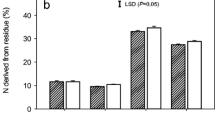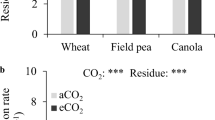Abstract
Increased atmospheric carbon dioxide (CO2) concentration will likely cause changes in plant productivity and composition that might affect soil decomposition processes. The objective of this study was to test to what extent elevated CO2 and N fertility-induced changes in residue quality controlled decomposition rates. Cotton (Gossypium hirsutum L.) was grown in 8-l pots and exposed to two concentrations of CO2 (390 or 722 μmol mol-1) and two levels of N fertilization (1.0 or 0.25 g l-1 soil) within greenhouse chambers for 8 wks. Plants were then chemically defoliated and air-dried. Leaf, stem and root residues were assayed for total non-structural carbohydrates (TNC), lignin (LTGA), proanthocyanidins (PA), C and N. Respiration rates of an unsterilized sandy soil (Lakeland Sand) mixed with residues from the various treatments were determined using a soda lime trap to measure CO2 release. At harvest, TNC and PA concentrations were 17 to 45% higher in residues previously treated with elevated CO2 compared with controls. Leaf and stem residue LTGA concentrations were not significantly affected by either the elevated CO2 or N fertilization treatments, although root residue LTGA concentration was 30% greater in plants treated with elevated CO2. The concentration of TNC in leaf residues from the low N fertilization treatment was 2.3 times greater than that in the high N fertilization treatment, although TNC concentration in root and stem residues was suppressed 13 to 23% by the low soil N treatment. PA and LTGA concentrations in leaf, root and stem residues were affected by less than 10% by the low N fertilization treatment. N concentration was 14 to 44% lower in residues obtained from the elevated CO2 and low N fertilization treatments. In the soil microbial respiration assay, cumulative CO2 release was 10 to 14% lower in soils amended with residues from the elevated CO2 and low N fertility treatments, although treatment differences diminished as the experiment progressed. Treatment effects on residue N concentration and C:N ratios appeared to be the most important factors affecting soil microbial respiration. The results of our study strongly suggest that, although elevated CO2 and N fertility may have significant impact on post-harvest plant residue quality of cotton, neither factor is likely to substantially affect decomposition. Thus, C cycling might not be affected in this way, but via simple increases in plant biomass production.
Similar content being viewed by others
References
Akin D E, Rigsby L L, Gamble G R, Morrison W H, III, Kimball B A, Pinter P J, Jr., Wall G W, Garcia R L and LaMorte R L 1995 Biodegradation of plant cell walls, wall carbohydrates, and wall aromatics in wheat grown in ambient or enriched CO2 concentrations. J. Sci. Food Agric. 67, 399–406.
Ball A S and Drake B G 1997 Short-term decomposition of litter produced by plants grown in ambient and elevated atmospheric CO2 concentrations. Global Change Biol. 3, 29–35.
Bazzaz F A 1990 The response of natural ecosystems to the rising global CO2 levels. Ann. Rev. Ecol. Syst. 21, 167–196.
Boehringer Mannheim 1989 Starch. In Methods of Biochemical Analysis and Food Analysis Using Test-Combinations. pp 118–120. Boehringer Mannheim Corporation, Roche Diagnostics, Corp., Indianapolis, IN.
Booker F L, Anttonen S and Heagle A S 1996 Catechin, proanthocyanidin and lignin contents of loblolly pine (Pinus taeda L.) needles after chronic exposure to ozone. New Phytol. 132, 483–492.
Booker F L and Miller J E 1998 Phenylpropanoid metabolism and phenolic composition of soybean [Glycine max (L.) Merr.] leaves following exposure to ozone. J. Exp. Bot. 49, 1191–1202.
Cathey GW, Elmore C D and McMichael B L 1981 Some physiological responses of cotton leaves to foliar applications of potassium 3,4-dichloroisothiazole-5-carboxylate and S,S,S-tributyl phosphorotrithioate. Physiol. Plant. 51, 140–144.
Cotrufo M F and Ineson P 1996 Elevated CO2 reduces field decomposition rates of Betula pendula (Roth.) leaf litter. Oecologia 106, 525–530.
Cotrufo M F, Ineson P and Rowland A P 1994 Decomposition of tree leaf litters grown under elevated CO2: effect of litter quality. Plant Soil 163, 121–130.
Coûteaux M-M, Mousseau M, Célérier M-L and Bottner P 1991 Increased atmospheric CO2 and litter quality: decomposition of sweet chestnut leaf litter with animal food webs of different complexities. Oikos 61, 54–64.
Edmisten K 1999 Chemical defoliation. In 1999 Cotton Information. pp 135–154. North Carolina Cooperative Extension Service, Raleigh, NC.
Friend J 1992 Lignin and associated phenolic acids in cell walls. In Molecular Plant Pathology: A Practical Approach. Eds S J Gurr and M J McPherson. pp 9–14. IRL Press, Oxford.
Gahrooee F R 1998 Impacts of elevated atmospheric CO2 on litter quality, litter decomposability and nitrogen turnover rate of two oak species in a Mediterranean forest ecosystem. Global Change Biol. 4, 667–677.
Haynes R J 1986 The decomposition process: mineralization, immobilization, humus formation, and degradation. In Mineral Nitrogen in the Plant-Soil System. Ed. R J Haynes. pp 52–126. Academic Press, Inc., Orlando, FL.
Heck W W, Philbeck R B and Dunning J A 1978 A Continuous Stirred Tank Reactor (CSTR) System for Exposing Plants to Gaseous Air Contaminants: Principles, Specifications, Construction, and Operation. USDA Agricultural Research Service, Washington, D.C. p. 36 pp.
Henning F P, Wood C W, Rogers H H, Runion G B and Prior S A 1996 Composition and decomposition of soybean and sorghum tissues grown under elevated atmospheric carbon dioxide. J. Env. Qual. 25, 822–827.
Hirschel G, Körner C and Arnone J A, III 1997 Will rising atmospheric CO2 affect leaf quality and in situ decomposition rates in native plant communities? Oecologia 110, 387–392.
Hodges S C 1999 Fertilization. In 1999 Cotton Information. pp 43–55. North Carolina Cooperative Extension Service, Raleigh, NC.
Kemp P R, Waldecker D G, Owensby C E, Reynolds J F and Virginia R A 1994 Effects of elevated CO2 and nitrogen fertilization pretreatments on decomposition on tallgrass prairie leaf litter. Plant Soil 165, 115–127.
Lambers H 1993 Rising CO2, secondary plant metabolism, plant-herbivore interactions and litter decomposition. Vegetatio 104/105, 263–271.
O'Neill E G and Norby R J 1996 Litter quality and decomposition rates of foliar litter produced under CO2 enrichment. In Carbon Dioxide and Terrestrial Ecosystems. Eds G W Koch and H A Mooney. pp 87–103. Academic Press, San Diego, CA.
Pettigrew WT, Heitholt J J and Meredith WR, Jr.1993 Early season ethephon application effects on cotton photosynthesis. Agron. J. 85, 821–825.
Porter L J, Hrstich L N and Chan B G 1986 The conversion of procyanidins and prodelphinidins to cyanidin and delphinidin. Phytochemistry 25, 223–230.
Rogers H H, Jeffries H E, Stahel E P, Heck W W, Ripperton L A and Witherspoon A M 1977 Measuring air pollutant uptake by plants: a direct kinetic technique. J. Air Pollut. Control Assoc. 27, 1192–1197.
SAS Institute Inc. 1985 SAS User's Guide: Statistics, Version 5 Edition. SAS Institute, Inc., Cary, NC. 956 p.
Tesarova M and Gloser J 1976 Total CO2 output from alluvial soils with two types of grassland communities. Pedobiologia 16, 364–372.
Torbert H A, Prior S A and Rogers H H 1995 Elevated atmospheric carbon dioxide effects on cotton plant residue decomposition. Soil. Sci. Soc. Am. J. 59, 1321–1328.
Torbert H A, Prior S A, Rogers H H and Runion G B 1998 Crop residue decomposition as affected by growth under elevated atmospheric CO2. Soil Sci. 1663, 412–419.
van Ginkel J H, Gorissen A and van Veen J A 1996 Long-term decomposition of grass roots as affected by elevated atmospheric carbon dioxide. J. Env. Qual. 25, 1122–1128.
Waterman P G and Mole S 1994 Analysis of Phenolic Plant Metabolites. Blackwell Scientific Publications, Oxford. 238 p.
Wood C W, Torbert H A, Rogers H H, Runion G B and Prior S A 1994 Free-air CO2 enrichment effects on soil carbon and nitrogen. Agric. For. Meteorol. 70, 103–116.
Rights and permissions
About this article
Cite this article
Booker, F.L., Shafer, S.R., Wei, CM. et al. Carbon dioxide enrichment and nitrogen fertilization effects on cotton (Gossypium hirsutum L.) plant residue chemistry and decomposition. Plant and Soil 220, 89–98 (2000). https://doi.org/10.1023/A:1004773404948
Issue Date:
DOI: https://doi.org/10.1023/A:1004773404948




